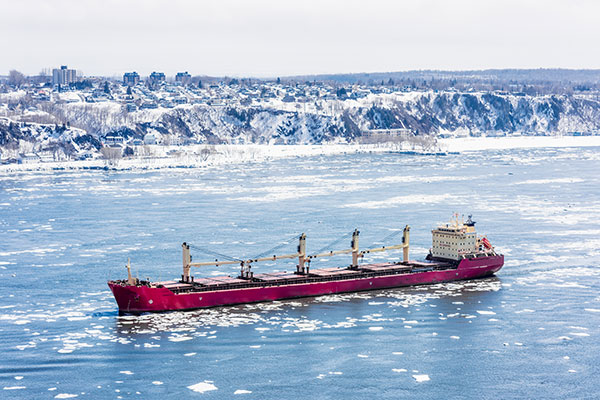As outlined in our current website feature, climate change may make the Arctic Ocean a viable alternative sea channel for global supply chain managers. In this exclusive Q&A interview with Hiba Baroud, Vanderbilt University Littlejohn Dean’s Faculty Fellow and assistant professor of civil and environmental engineering, we explore this issue in greather depth.
Supply Chain Management Review: What are some of the geopolitical considerations being evaluated?
Hiba Baroud: The questions we are asking in our research revolve around the risk of navigating the Arctic. We focus specifically on natural hazards such as sea ice concentration and extreme weather events. The outcome of our work can inform and guide the development of appropriate cross-border infrastructure and the planning for emergency response among countries along the route. For example, if a Russian vessel experiences a climate-related incident several miles off the coast in the Bering Strait, who will respond? Logistically, it would be the U.S. Coast Guard though there are political concerns should the Coast Guard board a Russian ship.
SCMR: What predictive models are currently underway?
Baroud: We are building a model that enables us to predict the likelihood of various climate-related incidents that can enable appropriate emergency response plans. Today, climate models are based on coarse data that works with limited variables. In this collaboration we are rerunning climate models to get very detailed data and to identify the exact variables that we want to investigate. The output will be a highly detailed analysis and granular understanding of the specific event (extreme weather, ice, wind, waves, etc.) that can be used to determine vessel design or where shippers should be putting their money. The implications of our research will impact when and how shippers consider utilizing the Northern Sea Route in the future.
SCMR: Any other issues?
Baroud: Outside of cross-border issues, we are looking at how an increase in shipping activity near the coastal areas in Alaska will impact indigenous communities. Aside from feeling the effects of climate change, these communities are forced to respond to the anthropogenic changes – including increased shipping activity – they face with increased urgency. There exists the potential for a drastic change in the lives of people living in these areas that we should not ignore.
SCMR: Are current trade tensions being taken into account?
Baroud: We are looking at the NSR’s viability as a profitable shipping route over the next century, so we are paying attention to the trade tensions that exist as a result of the current administration’s policies largely as a way to understand how shippers are making their decisions. The implications of the trade war in 2020 are also based on the dynamics of the logistics industry in 2020. It is fair to say that as we have a keener sense of the level of shipping activity in the Arctic in the coming decades, we would be able to model the impact of the current trade war as traffic shifts from the Suez Canal to the NSR. This is an interesting exercise and contributes to the total understanding of the decision-making factors that shippers have at their disposal.
SCMR: What new types of vessel designs are being evaluated?
Baroud: We are just initiating conversations with shippers, marine engineers and vessel procurement teams to get a better understanding of the costs involved in designing new ships, and how those costs may be offset by fuel savings. In our efforts to determine when the route could be profitable, we are looking at the cost of new vessels and ice breakers that could travel the NSR.
A very pricey and vital component of Arctic shipping is ice breakers. The U.S. owns only two ice breakers, and the bigger vessel has been experiencing severe breakdowns since 2018. The cost of acquiring and maintaining an ice breaker makes it critically important to understand the interplay of climate on shipping conditions, and how that figures into our cost-benefit analysis.
To date, this analysis has used data from reports on previous trips along the Northwest Passage to give us a way to calculate the probability of potential incidents. We took these trips as an absolute value, and in the future look forward to collaborating more closely with shippers to glean more information and make even more accurate calculations. Because we’re looking at the entire route rather than from a single shipper’s standpoint, these discussions can be very helpful.
SCMR: What about port infrastructure?
Baroud: While the route and weather and sea ice conditions along the NSR are the focal points of our work, we must acknowledge that port operations are an essential component of shipping. Without a strong port, the route’s viability is nil. The Port of Adak in Alaska will require significant investment to expand and develop into one that can sustain an uptick of docked vessels and activity throughout extreme weather events. We aim to avoid a “chicken or egg” scenario, instead asking questions about the relevance of port development and answering them with hard data over the course of this project.
SC
MR


Latest Supply Chain News
- Few executives believe their supply chains can respond quickly to disruptions
- Technology’s role in mending supply chain fragility after recent disruptions
- Tech investments bring revenue increases, survey finds
- Survey reveals strategies for addressing supply chain, logistics labor shortages
- Israel, Ukraine aid package to increase pressure on aerospace and defense supply chains
- More News
Latest Podcast

 Explore
Explore
Business Management News
- Few executives believe their supply chains can respond quickly to disruptions
- Technology’s role in mending supply chain fragility after recent disruptions
- Survey reveals strategies for addressing supply chain, logistics labor shortages
- How CPG brands can deliver on supplier diversity promises
- How S&OP provides the answer to in-demand products
- AI, virtual reality is bringing experiential learning into the modern age
- More Business Management
Latest Business Management Resources

Subscribe

Supply Chain Management Review delivers the best industry content.

Editors’ Picks





